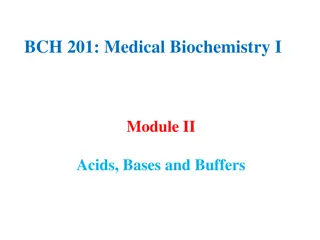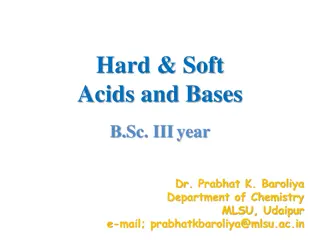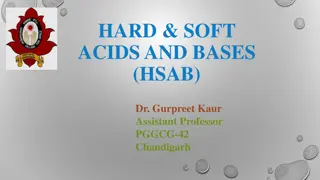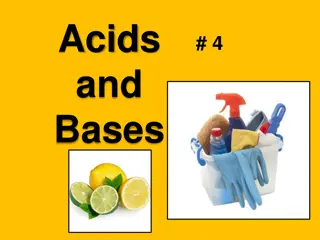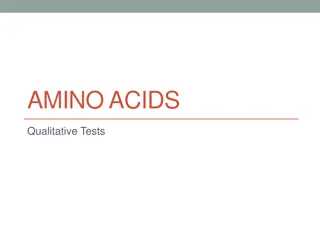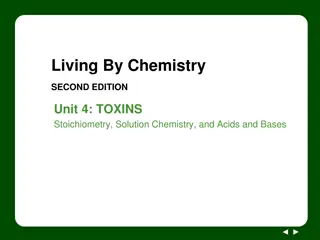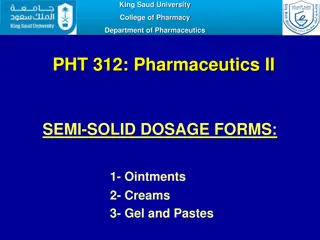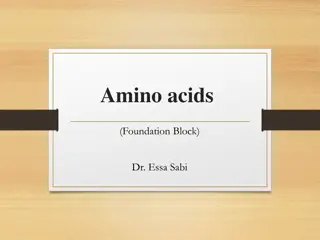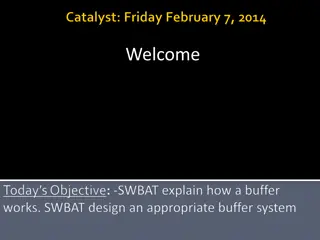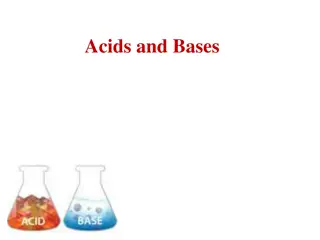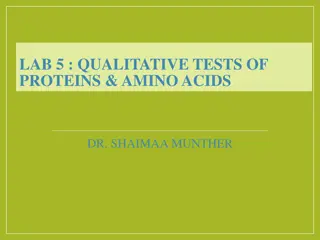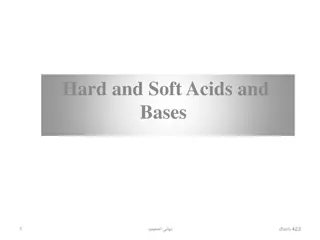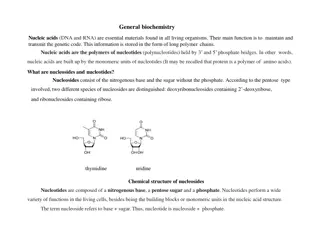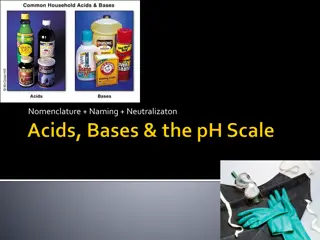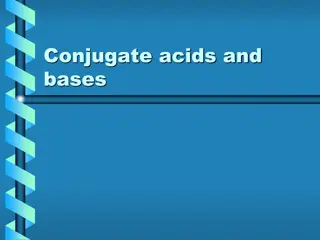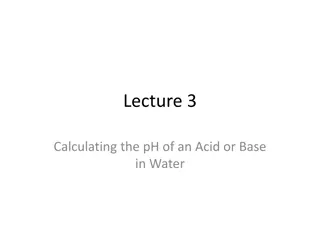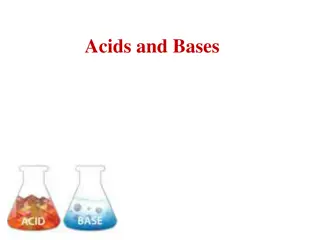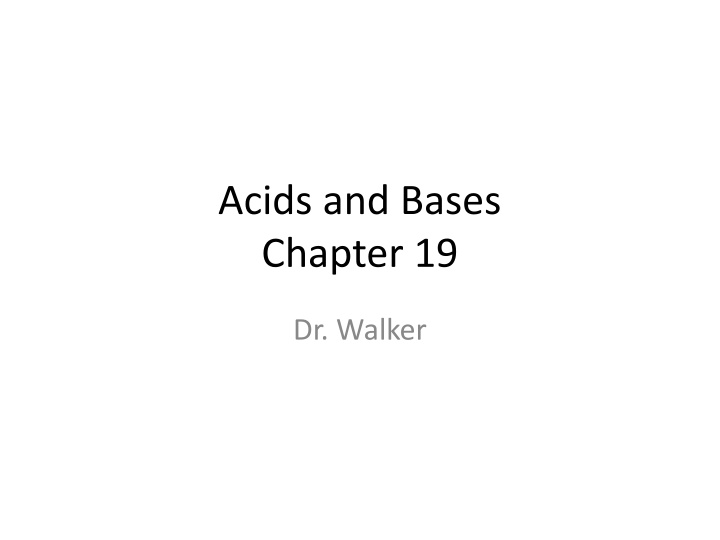
Acids and Bases Properties Explained
The properties and behaviors of acids and bases, including neutralization reactions, common examples, and definitions according to Arrhenius and Bronsted-Lowry theories. Learn about strong versus weak acids and bases with detailed visual aids.
Download Presentation

Please find below an Image/Link to download the presentation.
The content on the website is provided AS IS for your information and personal use only. It may not be sold, licensed, or shared on other websites without obtaining consent from the author. If you encounter any issues during the download, it is possible that the publisher has removed the file from their server.
You are allowed to download the files provided on this website for personal or commercial use, subject to the condition that they are used lawfully. All files are the property of their respective owners.
The content on the website is provided AS IS for your information and personal use only. It may not be sold, licensed, or shared on other websites without obtaining consent from the author.
E N D
Presentation Transcript
Acids and Bases Chapter 19 Dr. Walker
Neutralization Reactions HX + MOH H2O + MX
Common Bases NaOH Sodium Hydroxide Potassium Hydroxide Magnesium Hydroxide Lye KOH Liquid Soaps Mg(OH)2 Milk of Magnesia (antacid) Maalox (antacid) Al(OH)3 Aluminum Hydroxide
Write text Defining Acids and Bases Arrhenius Acid/Base Arrhenius Acid: Increases H3O+ (aka H+, proton) concentration HCl + H2O H3O+ + Cl-
Write all Defining Acids and Bases Arrhenius Base: Increases OH- concentration NaOH Na+ + OH- Problem Some bases don t have OH-!
Write all Defining Acids and Bases Bronsted-Lowry Acids: Proton Donor Bases: Proton Acceptor Proton: Hydrogen atom that has lost it s electron (H+)
Bronsted-Lowry NH4+ + OH- NH3 + H2O Base Acid Acid Base According to the Bronsted-Lowry definition, water acts as an acid because it gives up a proton!
Strong and Weak Acids/Bases Strong Acid dissociates completely in solution -Notice the HCl completely breaks apart -Tends to be smaller molecules Weak Acid dissociates partially in solution Notice the acetic acid stays mostly intact -Tends to be larger, organic molecules
Electrolytes Solutions that can conduct electricity Requires ions in solution (H+, Na+, Cl- , etc.) Strong electrolytes High ion content Dissociate completely in solution (strong acids/bases) Weak electrolytes Lower ion content Dissociate partially in solution (weak acids/bases) Non-electrolytes No dissocation, hence no ions in solution Organic molecules
Amphoteric Amphoteric has properties of an acid and a base. Can act as either depending on situation NH3 + H2O NH4+ + OH- Water is the acid H2O + HCl H3O+ + Cl- Water is the base
Self-Ionization of Water H2O H+ + OH- This happens in every glass of water This occurs in low enough concentration that it is not noticeable [H+] = [OH-] = 1.0 x 10-7 M [H+][OH-]= 1.0 x 10-14 M
Concentration Concentration is expressed in Molarity (M = moles/liter) Concentration is shown with [ ] brackets 0.1 = [HCl] The HCl concentration is 0.1 M
The pH Scale pH = power of Hydrogen pH measures hydrogen ion concentration The pH scale is a way of expressing the strength of acids and bases. Instead of using very small numbers, we just use the NEGATIVE power of 10 on the molarity of the H+ ion.
The pH Scale pH < 7 Acidic pH = 7 Neutral pH > 7 Basic
Calculating pH Works on powers of 10 Scientific Notation Entering problems into the Calculator Number EE (Ti-30) or exp ($ 1/Casio) Exponent Solve by hitting log , +/- Do not hit the multiply button!!!!! It will mess you up!
Calculating pH pH = - log [H3O+] Example: [H3O] = 1.0 x 10-5 Note: This number is a molarity (or concentration!!) You re given this most of the time, but you could have to calculate it! log [1.0 x 10-5] = -5 -log [1.0 x 10-5] = 5 pH = 5
Other Examples What is the pH of a 5.0 x 10-6 solution of sulfuric acid? What is the pH of a 1.4 x 10-10 solution of hydrochloric acid? What is the pH of a solution of HCl containing 0.1 moles and 2.5 L total volume?
Other Examples What is the pH of a 5.0 x 10-6 solution of sulfuric acid? 5.0, ee/exp, 6, (+/-) Log, (+/-) = 5.30 What is the pH of a 1.4 x 10-10 solution of hydrochloric acid? = 9.85 What is the pH of a solution of HCl containing 0.1 moles and 2.5 L total volume? Find molarity, take log of that (-log [0.1/2.5]) = 1.40
Finding [H3O+] from pH You can perform the reverse and determine [H3O+] from p [H3O+] = 10-pH What is the hydronium concentration of a solution with pH = 9.7 ? [H3O+] = 10-pH [H3O+] = 10-9.7 [H3O+] = 1.99 x 10-10
Fighting the Calculator What is the hydronium concentration of a solution with pH = 9.7 ? [H3O+] = 10-pH [H3O+] = 10-9.7 pH, (+/-), 2nd function, log [H3O+] = 1.99 x 10-10
Examples What is the hydronium concentration of a solution with pH = 11.2? What is the hydronium concentration of a solution with pH = 1.9?
Examples What is the hydronium concentration of a solution with pH = 11.2? 11.2, (+/-), 2nd function, log = 6.31 x 10-12 What is the hydronium concentration of a solution with pH = 1.9? = 0.013 or 1.3 x 10-2 Note: For decimals with only a few zeros, the calculator won t convert to scientific notation for you.
pOH Measures Hydroxide (OH-) concentration pOH = -log [OH-] pH + pOH = 14 What is the pOH of a solution with a pH = 6.7? pH + pOH = 14 6.7 + pOH = 14 pOH = 7.3
pH Testing There are several ways to test pH Blue litmus paper (red = acid) Red litmus paper (blue = basic) pH paper (multi-colored) pH meter (7 is neutral, <7 acid, >7 base) Universal indicator (multi-colored) Indicators like phenolphthalein Natural indicators like red cabbage, radishes
pH Indicators Indicators are dyes that can be added that will change color in the presence of an acid or base. Some indicators only work in a specific range of pH Once the drops are added, the sample is ruined Some dyes are natural, like radish skin, red cabbage, and beets
Indicator Questions What is the pH of solution if bromothymol blue turns blue and thymol blue turns yellow? A) 5.5 B) 7.3 C) 7.8 D) 8.7
Indicator Questions Notice bromothymol blue is blue above 7.6 Thymol blue is yellow below 8.0 The only choice that qualifies is c) 7.8
Titrations Titration: A method used to determine the unknown concentration of a substance in solution A buret is used for this Math involves a dilution calculation Remember, M1V1 = M2V2
Titrations Titrations use stoichiometry to determine endpoint of reactions (no I won t make you do it) Equivalence point # moles acid = # moles base in a titration If the proper indicator is chosen, the end point and equivalence point should be the same.
Titrations How could you tell when a titration is finished? Take the pH at given volume points with pH paper Indicators: you need to use an indicator that turns color when your titration is complete. End Point: Point in a titration where a color change takes place
Skills To Master Differentiating between acids and bases given specific properties Calculating pH, [H+], and pOH given one of these values Evaluating the proper indicator for a given pH range Evaluating the pH given colorimetric results from indicators

